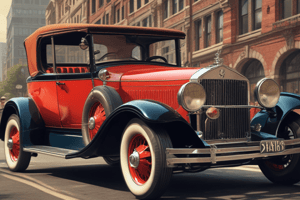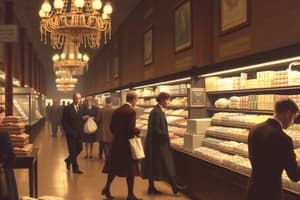Podcast
Questions and Answers
What was a major focus of the New Deal during Roosevelt's first 100 days in office?
What was a major focus of the New Deal during Roosevelt's first 100 days in office?
- Promoting a socialist economy
- Establishing a military-industrial complex
- Introducing improved management of the economy (correct)
- Completely eliminating regulations on businesses
What agency was considered the cornerstone of the New Deal?
What agency was considered the cornerstone of the New Deal?
- Social Security Administration
- Federal Reserve System
- Public Works Administration
- National Recovery Administration (correct)
Why did Roosevelt gather a group of advisers during his presidency?
Why did Roosevelt gather a group of advisers during his presidency?
- To promote isolationist policies
- To push for arms disarmament agreements
- To focus on a strict interpretation of the Constitution
- To implement sweeping changes to the economy (correct)
What did the National Recovery Administration do?
What did the National Recovery Administration do?
What was the outcome of the Supreme Court's decision regarding the NRA in 1935?
What was the outcome of the Supreme Court's decision regarding the NRA in 1935?
What major criticism did Roosevelt have towards Hoover during the 1932 election?
What major criticism did Roosevelt have towards Hoover during the 1932 election?
What type of projects did the Public Works Administration primarily fund?
What type of projects did the Public Works Administration primarily fund?
What did Roosevelt mean by a 'new deal' for the American people?
What did Roosevelt mean by a 'new deal' for the American people?
What was one significant outcome of the establishment of the Social Security Act in 1935?
What was one significant outcome of the establishment of the Social Security Act in 1935?
Which organization was created to regulate stock and bond markets during Roosevelt's New Deal?
Which organization was created to regulate stock and bond markets during Roosevelt's New Deal?
What was the membership increase in labor unions from 1933 to 1940?
What was the membership increase in labor unions from 1933 to 1940?
What phase of the New Deal is referred to as the reform phase?
What phase of the New Deal is referred to as the reform phase?
What was a major criticism of the New Deal according to historians?
What was a major criticism of the New Deal according to historians?
Which governmental body was responsible for outlawing unfair labor practices?
Which governmental body was responsible for outlawing unfair labor practices?
What significant shift did Roosevelt's programs represent in American economic philosophy?
What significant shift did Roosevelt's programs represent in American economic philosophy?
Which of the following was NOT a goal of the New Deal?
Which of the following was NOT a goal of the New Deal?
What was one key outcome of the New Deal regarding government policy?
What was one key outcome of the New Deal regarding government policy?
How did Roosevelt's approach to economic policy differ from his predecessors?
How did Roosevelt's approach to economic policy differ from his predecessors?
Which economic theory emerged from the New Deal and influenced post-World War II policies?
Which economic theory emerged from the New Deal and influenced post-World War II policies?
What significant shift occurred in the federal civil service as a result of the New Deal?
What significant shift occurred in the federal civil service as a result of the New Deal?
What was one legacy of the New Deal regarding public expectation?
What was one legacy of the New Deal regarding public expectation?
Which significant economic strategy did Roosevelt consider to be a last resort?
Which significant economic strategy did Roosevelt consider to be a last resort?
What fundamental belief remained intact despite the New Deal changes?
What fundamental belief remained intact despite the New Deal changes?
Who became a prominent advocate for an economic theory known as 'Reaganomics' in the 1980s?
Who became a prominent advocate for an economic theory known as 'Reaganomics' in the 1980s?
Flashcards
CCC Training
CCC Training
The Civilian Conservation Corps (CCC) provided jobs for young people to improve forests and parks.
SEC Regulation
SEC Regulation
The Securities and Exchange Commission (SEC) was created to regulate stocks and bonds, preventing market crashes.
FDIC Guarantee
FDIC Guarantee
The Federal Deposit Insurance Corporation (FDIC) protected savings by guaranteeing bank deposits.
New Deal's Intervention
New Deal's Intervention
Signup and view all the flashcards
Social Security Act (1935)
Social Security Act (1935)
Signup and view all the flashcards
National Labor Relations Board (NLRB)
National Labor Relations Board (NLRB)
Signup and view all the flashcards
New Deal's Economic Failure
New Deal's Economic Failure
Signup and view all the flashcards
Wartime Economic Recovery
Wartime Economic Recovery
Signup and view all the flashcards
New Deal
New Deal
Signup and view all the flashcards
Constitutional liberties
Constitutional liberties
Signup and view all the flashcards
American welfare system
American welfare system
Signup and view all the flashcards
Mixed economy
Mixed economy
Signup and view all the flashcards
Deficit spending
Deficit spending
Signup and view all the flashcards
Keynesian economics
Keynesian economics
Signup and view all the flashcards
Reaganomics
Reaganomics
Signup and view all the flashcards
Centrally planned system
Centrally planned system
Signup and view all the flashcards
FDR's Economic Philosophy
FDR's Economic Philosophy
Signup and view all the flashcards
New Deal's Goal
New Deal's Goal
Signup and view all the flashcards
NRA's Role
NRA's Role
Signup and view all the flashcards
NRA and Collaboration
NRA and Collaboration
Signup and view all the flashcards
NRA's Fate
NRA's Fate
Signup and view all the flashcards
Public Works Administration (PWA)
Public Works Administration (PWA)
Signup and view all the flashcards
Roosevelt's Leadership Style
Roosevelt's Leadership Style
Signup and view all the flashcards
Roosevelt's New Deal
Roosevelt's New Deal
Signup and view all the flashcards
Study Notes
The American Economy
- The case study analyzes the relationship between the US federal government and the economy in the 1920s and 1930s.
- It details how economic ideas about government intervention changed over time and how it reflected in government policy.
- The case study explains the causes of the 1929 stock market crash, President Roosevelt's response to the Great Depression, and how the US's current limited welfare state and mixed economy developed from the New Deal reforms.
United States at a Glance (1995 statistics)
- Area: 9,372,610 km²
- Population: 263.8 million (third-largest globally)
- Life expectancy (1994): Males 72.6 years, Females 79.4 years
- GDP (1994): $6,638.2 billion (US)
- GDP per capita (1994): $24,300 (US)
- Doctors per 1000 people (1993): 2.38
- Hospital beds per 1000 people (1993): 4.4
- Health expenditures as % of GDP (1990): 12.7%
- Telephones per 1000 people (1994): 590
- Televisions per 1000 people (1992): 814
Learning Outcomes
- Explain Republican economic policies (1921-1929).
- Understand the weaknesses of the 1920s economy and causes of the 1929 stock market crash and subsequent depression.
- Understand how the stock market operates.
- Explain the reasoning behind the New Deal.
- Analyze the successes and failures of the New Deal.
- Understand the historical roots of the American welfare state.
The Harding Administration
- During World War I, the government intervened in the economy extensively.
- Many Americans desired a return to a pre-war, stable economy.
- Warren G. Harding, president in 1921, aimed for "normalcy".
- His policies reflected a desire to reduce government involvement in business.
- The Harding administration faced a recession in 1921.
- Treasury Secretary Andrew Mellon reduced federal spending and taxes, particularly for the wealthy.
The Coolidge Administration
- Coolidge embraced a non-interventionist approach.
- He declared, "the business of America is business."
- Tax reductions for the wealthy were continued during his presidency.
- The Supreme Court limited social legislation and state intervention from the era.
- Coolidge's administration supported business interests and limited government intervention.
The American Economy in the 1920s
- The 1920s were a period of booming business and increased living standards.
- Increased worker productivity and new technologies played a significant role.
- Henry Ford's assembly line led to mass production of automobiles.
- The increase in personal incomes and the availability of consumer goods influenced the popular mood.
- The 1920s saw a growing materialism amongst Americans.
The Stock Market Crash of 1929
- The stock market experienced rapid growth in the 1920s.
- Many Americans invested in stocks "on margin" (borrowing money to buy stocks).
- Warning signs of the potential crash existed before October 1929.
- Rapid price increases for stocks led to inflated stock prices.
- Black Tuesday, October 29, 1929, caused a significant decline in stock values.
- The stock market crash triggered an economic depression.
The Great Depression of the 1930s
- Other factors besides the stock market crash contributed to the Great Depression (including international economic issues).
- Increased productivity and production outpaced wages and demand.
- Distribution of wealth was heavily skewed towards the wealthy, limiting the purchasing power of most people.
- High level of corporate fraud had an impact on the markets.
- The inability of the government to adequately address the crisis contributed to its duration.
Roosevelt's New Deal
- Roosevelt's campaign promised a "New Deal" for the American people.
- His policies aimed to restore stability to the economy and provide relief for the needy.
- The New Deal involved the creation of government programs such as the Public Works Administration and the Civilian Conservation Corps.
- It created programs to aid business and workers, such as the National Recovery Administration.
- New Deal policies included the establishment of social security and other policies which established the American welfare state.
Depicting Poverty
- A viewpoint letter describes the hardships faced by families struggling with poverty during the Great Depression.
- The letter expresses the desperation and loss of hope amongst a portion of the general population during an economic crisis.
Studying That Suits You
Use AI to generate personalized quizzes and flashcards to suit your learning preferences.




